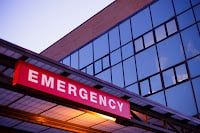Vinod Rao, M.D., Ph.D., of Massachusetts General Hospital, and colleagues used electronic health...
Hospital Incentive Program Found to Increase Buprenorphine Prescriptions for Patients With OUD

Pennsylvania patients with opioid use disorder (OUD) were more likely to receive a prescription for buprenorphine within 30 days of a visit to the emergency department (ED) if they were seen at a hospital participating in the state’s Opioid Hospital Quality Improvement Program than those seen at a hospital that did not participate in this program. These findings are described in a recent report in JAMA Health Forum.
“With surging rates of opioid overdose deaths, ED encounters present a crucial opportunity to engage patients with OUD treatment,” wrote Keisha T. Solomon, Ph.D., of Howard University and colleagues. “The [Opioid Hospital Quality Improvement Program] may be a new policy approach to expanding access to evidence-based treatment for OUD across a diverse and large population of hospitals.”
In response to high opioid overdose death rates, the Pennsylvania Department of Human Services in 2019 implemented the Opioid Hospital Quality Improvement Program—a statewide program that provides financial incentives to any hospital in the state that agreed to implement changes to increase the number of OUD patients who transition from the ED to follow-up OUD treatment, including buprenorphine.
The researchers analyzed data on 17,428 adults (about 57% male) who were enrolled in Medicaid and were seen in an ED for an opioid-related cause (for example, opioid withdrawal or opioid overdose) between January 1, 2016, and December 31, 2020. The main outcome was patients’ receipt of buprenorphine within 30 days of their ED visit.
A total of 14,585 patients with OUD sought care at a hospital ED that was participating in the Opioid Hospital Quality Improvement Program; 2,843 patients sought care at a hospital ED that was not participating in the program. Prior to the Opioid Hospital Quality Improvement Program, the baseline rate for patients prescribed buprenorphine within 30 days of their ED visit for an opioid overdose was similar between hospitals that were and were not participating in the program (5.0% and 5.7%, respectively), Solomon and colleagues noted. However, the researchers found that patients who visited an ED at a hospital participating in the program in 2020 were 3.6 percentage points more likely to receive buprenorphine treatment within 30 days than patients treated at nonparticipating hospitals.
“State programs that use financial incentives to drive OUD treatment practice changes in hospitals may be effective in improving quality and care transitions,” Solomon and colleagues wrote. “Similar programs across the nation should be considered as part of a multifaceted approach to mitigating the opioid epidemic.”
For related information, see the Psychiatric News article “High-Dose Buprenorphine in the ED Effective for OUD.”
(Image: iStock/MJFelt)
Don't miss out! To learn about newly posted articles in Psychiatric News, please sign up here.






